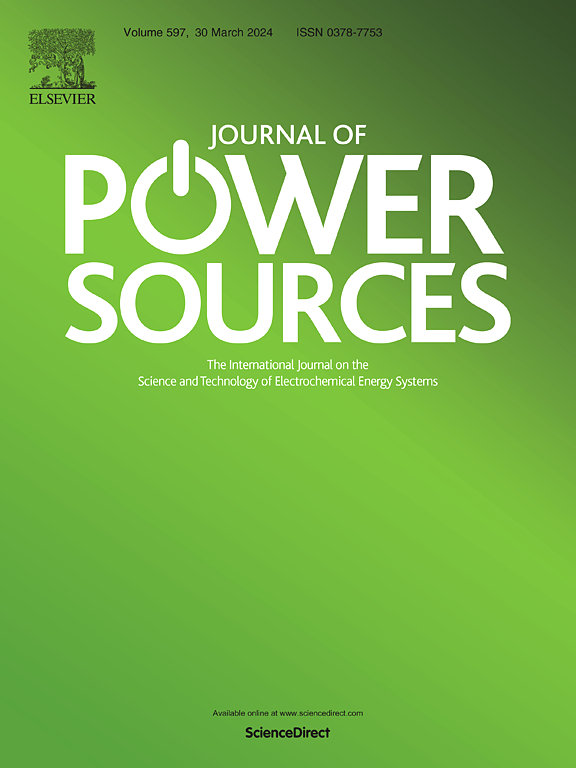Enhancing the trifunctional electrocatalytic activity of Fe-Co-Ni multi-component alloys using a zinc dealloying strategy
IF 8.1
2区 工程技术
Q1 CHEMISTRY, PHYSICAL
引用次数: 0
Abstract
The frequently-used Al dealloying technology is difficult to apply in the alloy electrodes prepared by the electrodeposition method. To address this issue, Zn with the excellent electrodeposition performances in aqueous solution is innovatively employed as a dealloying element in this work. Firstly, a simple electrodeposition method is used to synthesize a multi-component alloy containing Fe, Co, Ni, Cr, Mo, and Zn (NF-FCNCMZ0.05). The Zn is subsequently removed through dealloying in an alkaline solution, resulting in a multi-component alloy (NF-FCNCMZ0.05-D). NF-FCNCMZ0.05-D demonstrates the excellent trifunctional electrocatalytic activity, achieving the potentials of 1.50, 0.083, and 1.34 V vs. RHE at a current density of 100 mA cm−2 for oxygen evolution (OER), hydrogen evolution (HER), and methanol oxidation reaction (MOR), respectively. Furthermore, the electrolyzers using NF-FCNCMZ0.05-D as both cathode and anode for alkaline water and seawater splitting exhibit the low voltages. Replacing OER with MOR further reduces the water splitting voltage to 1.51 V at 100 mA cm−2, enabling the high selectivity (98.7 %) of formate production. This work provides a new strategy for enhancing the electrocatalytic performances of multi-component alloys prepared by electrodeposition.

采用锌合金化策略提高Fe-Co-Ni多组分合金的三功能电催化活性
常用的铝合金化技术难以应用于电沉积法制备的合金电极。为了解决这一问题,本研究创新性地采用了在水溶液中具有良好电沉积性能的锌作为合金元素。首先,采用简单的电沉积法合成了含Fe、Co、Ni、Cr、Mo、Zn的多组分合金(NF-FCNCMZ0.05)。随后在碱性溶液中通过脱合金除去Zn,得到多组分合金(NF-FCNCMZ0.05-D)。NF-FCNCMZ0.05-D表现出优异的三功能电催化活性,在100 mA cm−2的电流密度下,析氧反应(OER)、析氢反应(HER)和甲醇氧化反应(MOR)的电势分别为1.50、0.083和1.34 V。此外,以NF-FCNCMZ0.05-D为阴极和阳极的电解槽在碱性水和海水的分裂中表现出较低的电压。用MOR代替OER进一步降低了100 mA cm - 2时的水分解电压至1.51 V,实现了甲酸酯生产的高选择性(98.7%)。本研究为提高电沉积法制备的多组分合金的电催化性能提供了一种新的策略。
本文章由计算机程序翻译,如有差异,请以英文原文为准。
求助全文
约1分钟内获得全文
求助全文
来源期刊

Journal of Power Sources
工程技术-电化学
CiteScore
16.40
自引率
6.50%
发文量
1249
审稿时长
36 days
期刊介绍:
The Journal of Power Sources is a publication catering to researchers and technologists interested in various aspects of the science, technology, and applications of electrochemical power sources. It covers original research and reviews on primary and secondary batteries, fuel cells, supercapacitors, and photo-electrochemical cells.
Topics considered include the research, development and applications of nanomaterials and novel componentry for these devices. Examples of applications of these electrochemical power sources include:
• Portable electronics
• Electric and Hybrid Electric Vehicles
• Uninterruptible Power Supply (UPS) systems
• Storage of renewable energy
• Satellites and deep space probes
• Boats and ships, drones and aircrafts
• Wearable energy storage systems
 求助内容:
求助内容: 应助结果提醒方式:
应助结果提醒方式:


